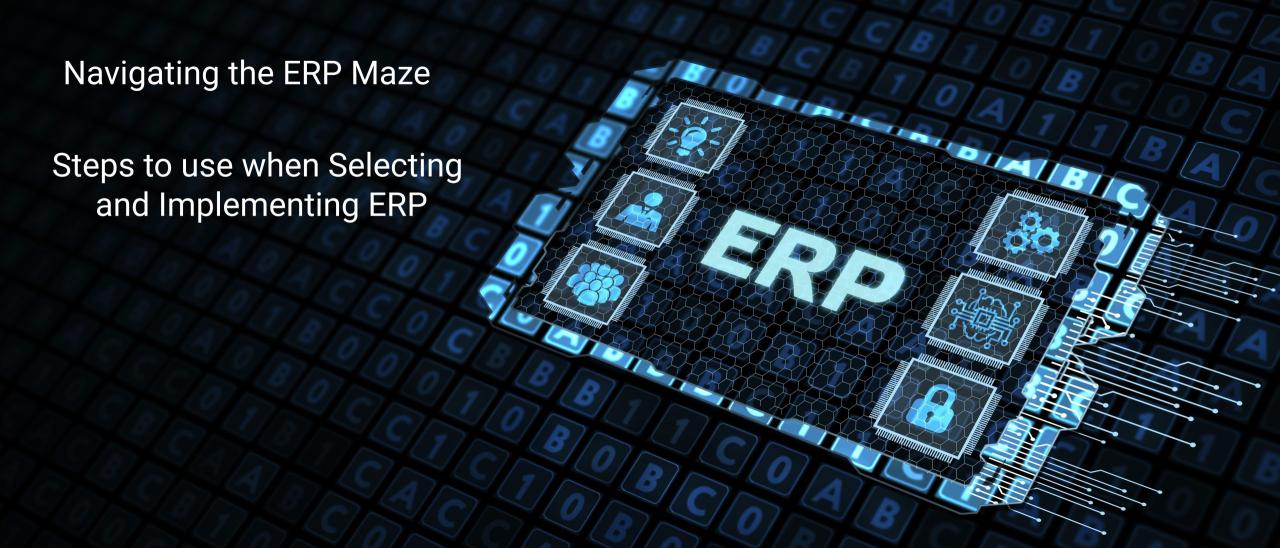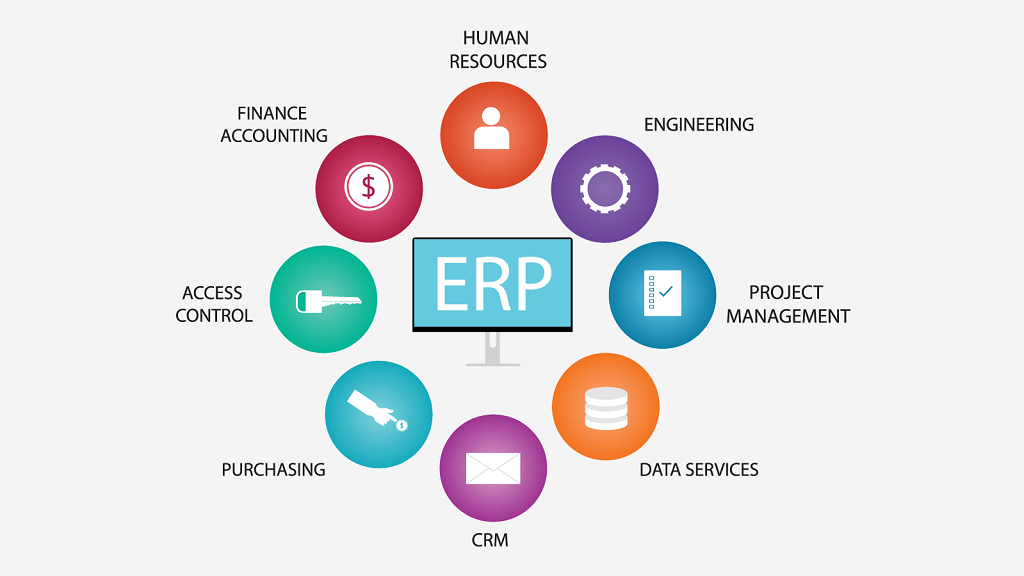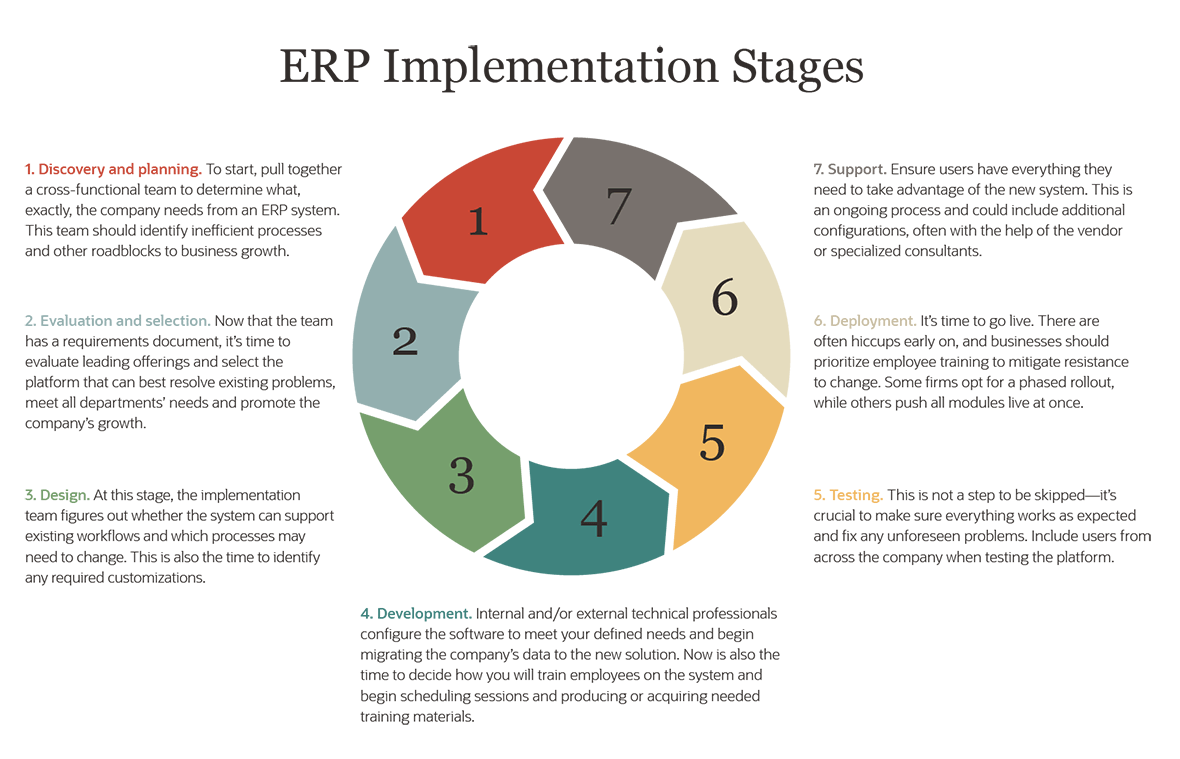Navigating the Maze: How ERP Software Can Empower Your Small Business
 .
.
Welcome, fellow entrepreneurs! In the bustling landscape of small businesses, navigating the complexities of managing operations can feel like traversing a labyrinth. From inventory control to customer relationship management, every aspect demands meticulous attention, leaving you yearning for a streamlined solution that can unify your business processes. Enter the world of Enterprise Resource Planning (ERP) software, a powerful tool that promises to be your compass in this intricate maze.
ERP software, in its essence, acts as a central hub for all your business functions, offering a comprehensive platform to manage everything from finance and accounting to inventory and customer interactions. It’s like having a virtual assistant who understands your business needs, automates repetitive tasks, and provides real-time insights to guide your decision-making. But with so many options available, choosing the right ERP software for your small business can feel overwhelming.
This comprehensive guide aims to demystify the world of ERP software for small businesses, providing you with the knowledge and insights you need to make an informed decision. We’ll delve into the benefits and challenges of implementing ERP, explore the key features that matter most, and guide you through the selection process. So, buckle up and let’s embark on this journey to discover how ERP software can empower your small business to reach new heights.
Understanding the Power of ERP Software: A Comprehensive Overview
 .
.
ERP software, often described as the "backbone" of modern businesses, has revolutionized how companies operate. It’s a centralized system that integrates all your business functions, eliminating the need for disparate, disconnected applications that often lead to data silos and inefficiencies. Imagine a single platform where you can track your inventory, manage customer relationships, analyze financial performance, and streamline your supply chain – that’s the power of ERP software.
But the true magic of ERP lies in its ability to empower you with real-time insights into your business. By consolidating data from all your departments, ERP provides a holistic view of your operations, allowing you to identify trends, analyze performance, and make informed decisions that drive growth. This data-driven approach helps you optimize your processes, reduce costs, and improve customer satisfaction.
Unlocking the Advantages of ERP Software for Small Businesses
The benefits of implementing ERP software for small businesses are vast and far-reaching. It’s not just about automating tasks; it’s about empowering your business to operate more efficiently, effectively, and strategically. Here’s a detailed look at the key advantages:
1. Enhanced Efficiency: Streamlining Operations for Maximum Productivity
Imagine a world where your employees spend less time on administrative tasks and more time focusing on core business activities. ERP software can make this dream a reality by automating repetitive processes, eliminating manual data entry, and reducing errors.

- Automated Workflow: ERP software automates tasks like order processing, invoice generation, and inventory management, freeing up your employees to focus on more strategic initiatives.
- Real-time Data Access: With centralized data storage, employees have access to the information they need, when they need it, eliminating time-consuming data searches and reducing communication bottlenecks.
- Improved Collaboration: ERP software fosters seamless communication and collaboration between departments, ensuring everyone is working towards the same goals and objectives.
 .
.
2. Enhanced Accuracy: Minimizing Errors and Ensuring Data Integrity
Data accuracy is paramount for any business, especially for small businesses where resources are often limited. ERP software plays a crucial role in ensuring data integrity by eliminating manual data entry and providing a single source of truth.
- Centralized Data Management: ERP software consolidates all your business data into a single database, eliminating the risk of inconsistencies and errors that can occur with multiple spreadsheets or disparate systems.
- Automated Data Validation: ERP software includes built-in validation rules to ensure data accuracy and prevent errors before they occur. This reduces the risk of costly mistakes and ensures your data is reliable.
- Improved Reporting and Analysis: With accurate data at your fingertips, you can generate insightful reports and analyze your business performance with greater confidence.
 .
.
3. Enhanced Visibility: Gaining Insights to Drive Strategic Decisions
In the fast-paced world of business, having real-time visibility into your operations is essential for making informed decisions. ERP software provides a comprehensive view of your business, allowing you to track key metrics, identify trends, and make strategic adjustments to optimize performance.
- Real-time Dashboards: ERP software provides interactive dashboards that display key performance indicators (KPIs) in real-time, giving you a clear picture of your business health.
- Data Analytics and Reporting: ERP software includes powerful analytics tools that allow you to analyze your data and identify patterns and trends. This insights-driven approach helps you make data-backed decisions.
- Predictive Analytics: Some advanced ERP systems offer predictive analytics capabilities, allowing you to forecast future trends and anticipate potential challenges.
 .
.
4. Enhanced Customer Satisfaction: Delivering Exceptional Experiences
In today’s competitive market, customer satisfaction is paramount. ERP software can help you improve your customer service by providing a centralized platform for managing customer interactions, tracking orders, and resolving issues efficiently.
- Customer Relationship Management (CRM): Many ERP systems include integrated CRM modules that allow you to manage customer interactions, track sales opportunities, and personalize your communication.
- Order Management: ERP software streamlines the order fulfillment process, ensuring orders are processed accurately and delivered on time.
- Customer Support: ERP software provides a centralized platform for managing customer support requests, tracking issues, and resolving them efficiently.
5. Enhanced Financial Management: Gaining Control of Your Finances
Financial management is a critical aspect of any business, and ERP software can provide you with the tools you need to gain control of your finances, track your cash flow, and make informed financial decisions.
- Accounting and Budgeting: ERP software integrates with accounting systems, allowing you to manage your accounts payable, accounts receivable, and financial reporting in real-time.
- Cash Flow Management: ERP software provides insights into your cash flow, helping you identify potential cash shortages and make informed financial decisions.
- Financial Reporting: ERP software generates comprehensive financial reports that provide a clear picture of your business’s financial health.
Navigating the Challenges of ERP Implementation: A Realistic Perspective
While the benefits of ERP software are undeniable, implementing it can present its own set of challenges. It’s important to be aware of these potential hurdles and develop a strategy to overcome them.
1. Cost of Implementation: Balancing Investment and Return on Investment
Implementing ERP software can be a significant investment, requiring upfront costs for software licenses, implementation services, and training. It’s crucial to carefully evaluate the cost of implementation against the potential return on investment (ROI).
- Software Licensing Costs: ERP software vendors offer various pricing models, including subscription-based plans, perpetual licenses, and tiered pricing based on user count.
- Implementation Services: Implementing ERP software requires specialized expertise, often necessitating the engagement of consultants or implementation partners.
- Training Costs: Training your employees on the new ERP system is essential for successful adoption. This can involve internal training programs or external training courses.
2. Complexity of Implementation: Navigating the Technical Hurdles
Implementing ERP software can be a complex process, requiring significant effort and coordination. The complexity of implementation can vary depending on the size and complexity of your business, the chosen ERP system, and the level of customization required.
- Data Migration: Migrating your existing data from legacy systems to the new ERP platform can be a challenging and time-consuming task.
- Integration with Existing Systems: Integrating your ERP system with other business applications, such as your accounting software or e-commerce platform, can be complex.
- Customization and Configuration: Customizing the ERP system to meet your specific business needs can be a complex and time-consuming process.
3. Resistance to Change: Overcoming Employee Hesitation
Implementing a new ERP system can disrupt existing workflows and require employees to adapt to new processes and technologies. This can lead to resistance to change, which can hinder the successful adoption of the new system.
- Communication and Training: Clear communication and comprehensive training are essential to overcome employee resistance. Employees need to understand the benefits of the new system and be provided with the necessary skills to use it effectively.
- Change Management Strategies: Implementing change management strategies, such as involving employees in the implementation process and providing support during the transition, can help reduce resistance.
- Incentivize Adoption: Offering incentives for early adoption or recognizing employees who embrace the new system can help encourage positive attitudes.
4. Data Security and Privacy: Safeguarding Your Business Information
ERP software stores a vast amount of sensitive business data, including financial information, customer details, and employee records. It’s crucial to ensure the security and privacy of this data to protect your business and comply with regulations.
- Data Encryption: Ensure the ERP system uses robust data encryption to protect sensitive information from unauthorized access.
- Access Controls: Implement strong access controls to limit access to sensitive data to authorized personnel.
- Regular Security Audits: Conduct regular security audits to identify and address potential vulnerabilities.
Choosing the Right ERP Software for Your Small Business: A Step-by-Step Guide
Selecting the right ERP software for your small business is a critical decision that can have a significant impact on your success. Here’s a step-by-step guide to help you navigate the selection process:
1. Define Your Business Needs: Identifying Your Specific Requirements
Before you start evaluating ERP software options, it’s crucial to define your specific business needs. Consider the following factors:
- Industry-Specific Requirements: Different industries have unique requirements. For example, a manufacturing company will have different needs than a retail business.
- Business Processes: Identify the key business processes you want to automate and improve.
- Scalability: Choose an ERP system that can scale with your business as you grow.
- Budget: Determine your budget for software licenses, implementation services, and ongoing maintenance.
2. Research and Evaluate Options: Exploring the ERP Landscape
Once you have a clear understanding of your business needs, you can start researching and evaluating different ERP software options.
- Industry-Specific ERP Solutions: Consider ERP software solutions designed specifically for your industry. These solutions often offer pre-configured modules and functionalities tailored to your industry’s unique requirements.
- Cloud-Based vs. On-Premise Solutions: Cloud-based ERP solutions are hosted on the vendor’s servers, while on-premise solutions are installed on your own servers. Consider the advantages and disadvantages of each option.
- Read Reviews and Case Studies: Research online reviews and case studies to get insights into the experiences of other businesses using different ERP software solutions.
3. Request Demonstrations and Trials: Getting Hands-on Experience
Once you’ve shortlisted a few ERP software options, request demonstrations and trials to get hands-on experience with the software. This will allow you to evaluate the user interface, functionality, and ease of use.
- Focus on Key Features: During the demonstrations, focus on the features that are most important to your business.
- Test Data Migration: If possible, test the data migration process to ensure your existing data can be migrated seamlessly.
- Evaluate Integration Capabilities: Test how the ERP system integrates with your existing systems.
4. Consider Implementation Costs and Support: Understanding the Total Cost of Ownership
When evaluating ERP software options, consider the total cost of ownership (TCO), which includes not only the software license cost but also implementation services, training, and ongoing support.
- Implementation Services: Get quotes from different ERP vendors for implementation services.
- Training Costs: Inquire about the cost of training for your employees.
- Ongoing Support: Consider the cost of ongoing support, including technical support, upgrades, and maintenance.
5. Negotiate and Finalize the Agreement: Securing the Best Deal
Once you’ve chosen an ERP software solution, negotiate the terms of the agreement with the vendor.
- Software License Agreement: Review the software license agreement carefully, paying attention to the terms of use, support, and maintenance.
- Implementation Timeline: Establish a clear implementation timeline with the vendor.
- Payment Terms: Negotiate favorable payment terms.
Maximizing Your ERP Investment: Implementing for Success
Once you’ve chosen and purchased your ERP software, it’s crucial to implement it effectively to maximize your investment. Here are some key tips for successful ERP implementation:
1. Establish Clear Goals and Objectives: Defining Your Implementation Roadmap
Before you begin the implementation process, define clear goals and objectives for your ERP project. This will provide a roadmap for your implementation efforts and ensure you’re on track to achieve your desired outcomes.
- Identify Key Business Processes: Determine the specific business processes you want to improve with the new ERP system.
- Set Measurable Goals: Set measurable goals for your ERP implementation project, such as reducing order processing time or improving inventory accuracy.
- Establish a Timeline: Create a realistic timeline for your ERP implementation project, including key milestones and deadlines.
2. Assemble a Strong Implementation Team: Building Your Implementation Squad
Implementing ERP software requires a dedicated team with the skills and experience to manage the process.
- Internal Stakeholders: Include representatives from different departments, such as finance, operations, and IT, to ensure all stakeholders are involved in the implementation process.
- External Consultants: Consider engaging external consultants with ERP implementation expertise to provide guidance and support.
- Project Manager: Appoint a project manager responsible for overseeing the implementation process and ensuring it stays on track.
3. Provide Comprehensive Training: Empowering Your Employees to Succeed
Training your employees on the new ERP system is essential for successful adoption.
- Develop Training Materials: Create comprehensive training materials, including user guides, online tutorials, and interactive training sessions.
- Offer Multiple Training Options: Provide various training options to cater to different learning styles, such as online courses, classroom sessions, and one-on-one coaching.
- Continuous Support: Offer ongoing support to employees after the initial training, such as FAQs, online forums, or dedicated support staff.
4. Manage Change Effectively: Embracing the New Normal
Implementing a new ERP system can be disruptive, so it’s important to manage change effectively to minimize resistance and ensure a smooth transition.
- Communicate Clearly: Communicate the benefits of the new ERP system to employees and address their concerns.
- Involve Employees: Encourage employee feedback and involve them in the implementation process.
- Recognize and Reward Adoption: Recognize and reward employees who embrace the new ERP system.
5. Monitor and Evaluate Performance: Optimizing Your ERP Investment
After implementing your ERP system, it’s important to monitor its performance and make adjustments as needed.
- Track Key Metrics: Track key performance indicators (KPIs) to measure the impact of the ERP system on your business.
- Collect User Feedback: Collect feedback from employees on their experiences with the new ERP system.
- Make Adjustments as Needed: Make adjustments to the ERP system or implementation process based on your findings.
FAQs: Addressing Your Burning Questions About ERP Software
1. What are the key features of ERP software for small businesses?
ERP software for small businesses typically includes modules for accounting, inventory management, customer relationship management (CRM), sales and marketing, and human resources.
2. What are the best ERP software options for small businesses?
Some popular ERP software options for small businesses include QuickBooks Online, Xero, NetSuite, Zoho One, and SAP Business One.
3. How much does ERP software cost for small businesses?
The cost of ERP software for small businesses can vary depending on the chosen solution, the number of users, and the level of customization required. Cloud-based ERP solutions typically offer subscription-based pricing models, while on-premise solutions often require a one-time purchase.
4. How long does it take to implement ERP software?
The implementation time for ERP software can vary depending on the complexity of the project, the size of your business, and the chosen ERP system. Typically, implementation projects can take anywhere from a few months to a year or more.
5. What are the benefits of using cloud-based ERP software?
Cloud-based ERP software offers several benefits, including scalability, affordability, accessibility, and ease of use.
6. What are the benefits of using on-premise ERP software?
On-premise ERP software offers greater control over your data and infrastructure, but it can be more expensive and complex to implement.
7. How can I choose the right ERP software for my business?
To choose the right ERP software, you need to define your business needs, research and evaluate options, request demonstrations and trials, consider implementation costs and support, and negotiate and finalize the agreement.
8. What are the challenges of implementing ERP software?
The challenges of implementing ERP software include the cost of implementation, complexity of implementation, resistance to change, and data security and privacy concerns.
9. How can I manage change effectively during ERP implementation?
To manage change effectively, you need to communicate clearly, involve employees, recognize and reward adoption, and provide ongoing support.
10. How can I maximize my ERP investment?
To maximize your ERP investment, you need to establish clear goals and objectives, assemble a strong implementation team, provide comprehensive training, manage change effectively, and monitor and evaluate performance.
11. What are the best practices for ERP implementation?
Best practices for ERP implementation include defining clear goals and objectives, assembling a strong implementation team, providing comprehensive training, managing change effectively, and monitoring and evaluating performance.
12. What are the key success factors for ERP implementation?
Key success factors for ERP implementation include executive sponsorship, clear communication, user involvement, comprehensive training, and effective change management.
13. How can I get started with ERP software?
To get started with ERP software, you need to define your business needs, research and evaluate options, and request demonstrations and trials.
Embarking on Your ERP Journey: A Call to Action
As you’ve delved into the world of ERP software, you’ve gained valuable insights into its potential to transform your small business. Now, it’s time to take action and embark on your own ERP journey.
- Start Your Research: Begin exploring the ERP landscape, researching different software options and comparing features, pricing, and implementation requirements.
- Seek Expert Guidance: Consider consulting with ERP experts or implementation partners to get personalized advice and support.
- Take the Plunge: Don’t let fear or uncertainty hold you back. Embrace the opportunity to empower your small business with the power of ERP software.
Remember, implementing ERP software is a journey, not a destination. It’s an ongoing process of learning, adapting, and optimizing. By embracing the challenges and leveraging the benefits, you can unlock the full potential of ERP software and propel your small business towards success.
Disclaimer: This article is intended for informational purposes only and should not be construed as financial or legal advice. The information provided is based on general industry knowledge and may not be applicable to all businesses. It is recommended to consult with qualified professionals for specific advice tailored to your unique situation.
 .
.

